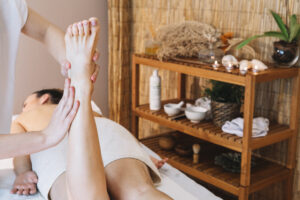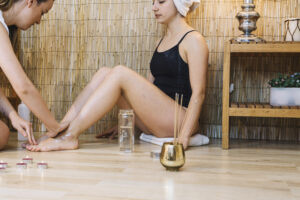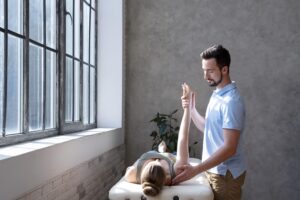
Introduction: My Journey into the World of Reflexology
As someone who spent years dealing with chronic stress and tension headaches, I never expected that the solution might be found in my feet. After trying countless remedies with limited success, a friend suggested reflexology. Skeptical but desperate, I scheduled my first session. The relief I felt afterward was immediate; my shoulders loosened, my headache dissipated, and for the first time in months, I slept through the night. This experience launched my fascination with reflexology therapy and its remarkable effects on overall wellness.
Whether you’re looking to manage stress, enhance your current wellness routine, or find complementary support for existing health concerns, reflexology offers a gentle yet powerful approach to better health. Let’s explore this ancient healing practice and discover how it might benefit you, too.
What Is Reflexology Therapy?
Reflexology is a therapeutic practice that involves applying pressure to specific points on the feet, hands, or ears. Unlike regular massage, which primarily works with soft tissues and muscles, reflexology focuses on precise reflex points that correspond to different organs, glands, and body systems.
The underlying principle of reflexology is that these reflex points connect to different parts of the body through energy pathways. When these pathways become blocked due to stress, illness, or injury, the corresponding body parts may experience dysfunction. By applying targeted pressure to specific reflex points, reflexologists aim to remove these blockages, restore energy flow, and promote healing throughout the body.
The History and Origins of Reflexology

While modern reflexology as we know it today gained popularity in the 20th century, the practice of foot therapy dates back thousands of years:
- Ancient Egypt (2330 BCE): Hieroglyphics in the Physician’s Tomb at Saqqara depict what appears to be foot and hand treatments.
- Traditional Chinese Medicine (2500+ years ago): Ancient Chinese medical texts reference working with feet and pressure points to balance “qi” (vital energy).
- Native American Practices: Various tribes practiced forms of foot therapy as part of their healing traditions.
- Modern Development: In the early 1900s, Dr. William Fitzgerald introduced “zone therapy” to Western medicine, dividing the body into ten vertical zones. Later, Eunice Ingham, known as the “mother of reflexology,” mapped the feet to corresponding body parts, developing the reflexology charts still used today.
This rich history demonstrates how cultures worldwide recognized the connection between feet and overall health long before modern science began studying these relationships.
How Does Reflexology Work?
The Zone Theory
Reflexology works on the premise that the body is divided into ten vertical zones running from the top of the head to the tips of the toes. Each zone corresponds to specific fingers, toes, and parts of the body. When pressure is applied to a reflex point within a zone, it affects the entire zone and all organs and body parts within that zone.
The Energy Pathway Concept
Similar to acupuncture and acupressure in Traditional Chinese Medicine, reflexology is based on the concept of “qi” or vital energy flowing through the body. When this energy becomes blocked, it can lead to imbalance and illness. Reflexology aims to remove these blockages and restore energy flow.
The Nervous System Connection
A more scientific explanation involves the nervous system. Reflexologists believe that applying pressure to specific points sends signals through the peripheral nervous system to the central nervous system, which then signals the body to adjust tension levels, increase circulation, and promote healing in the corresponding areas.
Reflex Points and Their Corresponding Body Parts
Each area of the foot corresponds to different parts of the body:
- Toes: Head, brain, sinuses, and teeth
- Ball of foot: Heart, chest, lungs, and thyroid
- Arch: Liver, pancreas, kidneys, and digestive organs
- Heel: Lower back, sciatic nerve, and pelvic area
- Ankle areas: Reproductive organs and lymphatic system
The reflexologist uses various techniques to stimulate these points, including thumb and finger pressure, rotation on a point, and other specialized movements.
Reflexology vs. Traditional Massage: Understanding the Difference
While both reflexology and massage therapy promote relaxation and wellness, they differ significantly in approach and technique:
| Reflexology | Traditional Massage |
| Focuses on reflex points in feet, hands, or ears | Works directly on muscles throughout the body |
| Aims to affect organs and systems indirectly | Directly addresses muscle tension and pain |
| Uses specific pressure techniques on small areas | Employs broader strokes and manipulations |
| Client remains fully clothed | Often requires undressing to some degree |
| Sessions typically last 30-60 minutes | Sessions can range from 30-90+ minutes |
| Based on energy pathway theories | Based on musculoskeletal anatomy |
Both practices can complement each other effectively. Many people find that combining regular massage therapy with periodic reflexology sessions provides comprehensive support for their wellness goals.
The Health Benefits of Reflexology Therapy
Research and anecdotal evidence suggest reflexology may offer numerous benefits:
Stress Reduction and Relaxation
Perhaps the most immediate and well-documented benefit of reflexology is its ability to induce deep relaxation. By calming the central nervous system, it can:
- Lower stress hormone levels
- Reduce muscle tension
- Improve sleep quality
- Promote mental clarity
Pain Management
Reflexology may help reduce pain through several mechanisms:
- Releasing endorphins (natural pain-killers)
- Improving circulation to affected areas
- Reducing tension that contributes to pain
- Supporting the body’s natural healing processes
Improved Circulation
The pressure techniques used in reflexology can stimulate blood flow throughout the body, potentially:
- Bringing oxygen and nutrients to cells more efficiently
- Removing metabolic waste and toxins
- Supporting organ function
- Enhancing healing and recovery
Enhanced Immune Function
By reducing stress and improving circulation, reflexology may support immune system function:
- Increasing lymphatic drainage
- Supporting the body’s natural detoxification processes
- Reducing inflammation
- Helping maintain overall health and resilience
Additional Potential Benefits
Many reflexology recipients report improvements in:
- Digestive issues
- Hormonal balance
- Sinus problems
- Headaches and migraines
- Energy levels
- Mental clarity
- Emotional well-being
Types of Reflexology
While foot reflexology is the most common form, there are several types of reflexology practice:
Foot Reflexology
The traditional and most widely practiced form focuses on the soles, tops, and sides of the feet. The feet contain over 7,000 nerve endings, making them particularly responsive to reflexology techniques.
Hand Reflexology
Follows similar principles as foot reflexology but works with points on the hands. This can be particularly useful for those who cannot have their feet worked on due to injury or preference. Hand reflexology is also convenient for self-treatment.
Ear Reflexology
Also known as auricular therapy, this focuses on reflex points in the ears. The ear is believed to contain points that correspond to all parts of the body, similar to a microsystem.
Facial Reflexology
A newer form that combines elements of acupressure and reflexology on the face. It may offer additional benefits for sinuses, headaches, and facial tension.
Common Reflexology Techniques
Reflexologists use various specialized techniques, including:
Thumb Walking
The primary technique is where the thumb “walks” across reflex points with controlled, even pressure. The movement is like an inchworm: compress, straighten, compress, straighten.
Finger Walking
Similar to thumb walking, but using the fingers when more delicate work is needed or when working in smaller areas.
Hook and Back-Up
A technique where the reflexologist hooks into a specific point and pulls back slightly to create focused pressure.
Rotation on a Point
Applying pressure while rotating on a specific reflex point to create deeper stimulation.
Finger and Thumb Compression
Direct pressure is applied to specific points using the thumb or finger.
What to Expect During Your First Reflexology Session
If you’re considering trying reflexology, here’s what a typical first session might involve:
Before the Session
- Your reflexologist will take a brief health history
- You’ll discuss your specific concerns or health goals
- The practitioner will explain their approach and what to expect
During the Session
- You’ll remain fully clothed, removing only your shoes and socks
- You’ll sit in a comfortable reclining chair or lie on a massage table
- The reflexologist may begin with relaxation techniques for your feet
- They’ll work methodically across all reflex points
- Some areas may feel tender or sensitive. This is normal and may indicate areas that need attention
- Sessions typically last 30-60 minutes
After the Session
- You may feel deeply relaxed or energized
- It’s recommended to drink plenty of water
- You might notice changes in sleep, digestion, or energy levels
- Some people experience a mild “healing response” as the body detoxifies
Is Reflexology Safe for Everyone?
While reflexology is generally considered safe for most people, there are some precautions to be aware of:
Who Should Avoid or Modify Reflexology
Consult with your healthcare provider before trying reflexology if you have:
- Deep vein thrombosis (DVT) or blood clots
- Foot fractures or recent foot surgery
- Active foot infections or wounds
- Gout flare-ups
- Osteoporosis that affects the feet
- Pregnancy (certain pressure points should be avoided)
A qualified reflexologist will know how to modify treatments for various conditions and will always prioritize your safety and comfort.
The Science Behind Reflexology: What Research Shows
The scientific study of reflexology is still evolving, with research showing mixed but promising results:
Stress and Anxiety Reduction
Multiple studies have demonstrated reflexology’s effectiveness for reducing stress and anxiety. A 2014 review found that reflexology helped lower blood pressure and cardiac index in patients with various conditions.
Pain Management
Research has shown potential benefits for specific types of pain:
- A study of cancer patients found reduced pain after reflexology treatments
- Women with PMS reported significant reductions in pain symptoms
Quality of Life Improvements
A randomized controlled trial found that women with early breast cancer who received reflexology reported better quality of life compared to those who received only standard support.
While more large-scale studies are needed to fully understand reflexology’s effects, existing research suggests it can be a valuable complementary therapy, particularly for stress reduction and quality of life improvements.
How to Find a Qualified Reflexologist
To ensure you’re working with a properly trained practitioner:
- Look for certification: In the US, seek therapists certified by the American Reflexology Certification Board (ARCB) or who have registered with the Reflexology Association of America.
- Check their training: Qualified reflexologists should have completed at least 110 hours of formal training.
- Ask about experience: Inquire about their experience working with your specific health concerns.
- Seek recommendations: Personal referrals or reviews can help identify skilled practitioners.
- Interview them: Don’t hesitate to ask questions about their approach and expertise before booking.
Self-Reflexology: Techniques You Can Try at Home
While professional sessions offer the most comprehensive benefits, you can practice some simple reflexology techniques at home:
Basic Hand Reflexology for Stress Relief
- Apply gentle pressure with your thumb to the center of your palm (solar plexus point)
- Make small circular motions for 30-60 seconds
- Repeat, on the other hand
Simple Foot Relaxation Technique
- Sit comfortably with one foot resting on the opposite knee
- Apply lotion or oil to your feet for smoother movement
- Use your thumbs to press and rotate along the arch of your foot
- Work from heel to toe, spending extra time on any tender areas
- Repeat on the other foot
Reflexology Tools for Home Use
Several tools can enhance your self-reflexology practice:
- Reflexology socks with mapped points
- Wooden foot rollers
- Reflexology mats
- Hand reflexology tools
Remember that self-practice is complementary to professional sessions, not a replacement for them.
Integrating Reflexology into Your Wellness Routine
For maximum benefits, consider how reflexology fits into your overall wellness plan:
Frequency Recommendations
- For stress management: 1-2 sessions monthly
- For chronic conditions: Weekly sessions initially, then biweekly
- For maintenance: Every 4-6 weeks
- For acute issues: 2-3 sessions in close succession
Complementary Practices
Reflexology works well alongside:
- Regular exercise
- Proper hydration
- Balanced nutrition
- Meditation or mindfulness
- Other bodywork modalities
- Conventional medical care
FAQs About Reflexology Therapy
How long does it take to feel results from reflexology?
Most people experience immediate relaxation benefits after a single session. For specific health concerns, a series of 4-6 weekly sessions is typically recommended before evaluating progress. Some conditions may require ongoing maintenance.
Does reflexology hurt?
Reflexology should not be painful, though you may experience moments of “good pain” or tender spots that indicate areas needing attention. A good reflexologist will adjust pressure to your comfort level and communicate throughout the session.
Can reflexology help with my specific health condition?
While reflexology is not a cure or treatment for medical conditions, many people with various health challenges report improvements in symptoms and quality of life. It’s best used as a complementary approach alongside appropriate medical care.
What does it mean if certain reflexology points are painful?
Tender areas during a reflexology session may indicate energy blockages or imbalances in the corresponding body parts. Regular sessions often reduce this tenderness as energy flow improves.
Is one session enough to experience benefits?
Most people feel a relaxation benefit after one session, but for addressing specific concerns, a series of sessions is typically recommended. Like most holistic practices, reflexology tends to have cumulative benefits with regular application.
Conclusion: Taking the First Step Toward Reflexology Benefits

Reflexology offers a gentle yet potentially powerful addition to your wellness routine. While it shouldn’t replace conventional medical care, its ability to reduce stress, promote relaxation, and potentially support the body’s natural healing processes makes it worth considering for many health-conscious individuals.
Whether you’re dealing with chronic stress, seeking pain management solutions, or simply looking to enhance your overall well-being, reflexology provides a non-invasive, holistic approach that honors the body’s interconnectedness.
If you’re intrigued by the possibilities, consider scheduling a session with a qualified reflexologist. Your feet and your whole body might thank you for it.
Remember that your health journey is personal, and the best approach is often one that thoughtfully combines conventional and complementary practices tailored to your unique needs.
Have you tried reflexology therapy? We’d love to hear about your experiences in the comments below!
This article is for informational purposes only and does not constitute medical advice. Always consult with qualified healthcare providers for medical concerns.